A few quick steps for those hiking Bryce Canyon’s Under the Rim Trail, and poof…..
The backcountry hiker is ushered into a sacred world of magical silence, immediately removed from the maddening crowds gathered at trailheads and overlooks far above…

Guide to Bryce Canyon
Under the Rim Trail
The Under the Rim Trail is a 22.9-mile trail that drops down below the park’s famed hoodoos. Hiking Bryce Canyon’s Under the Rim Trail does not lead one through the hoodoos, rather it provides a different perspective. Hikers are forced to look up toward these majestic structures.
The trail runs parallel to Bryce’s tall, pinkish cliffs through a series of horseshoe-shaped amphitheaters as it makes its way northward, or southward, depending upon your chosen direction of travel.
This trail is rugged. There are no services, no bathrooms, no ice cream stands. Sparse amounts of water to be found along the route. There is little maintenance at all on the trail’s southern section. Hundreds of downed trees complicate travel for those with a heavy pack.
At one point in this area, hikers will encounter a landslide, which has completely covered the trail. This spot will likely require many to negotiate the terrain with care. This is not a good first backpacking trip… Or maybe it is…
That said, those seeking solitude and a true backcountry experience will find exactly what they are looking for while hiking the Under the Rim Trail.
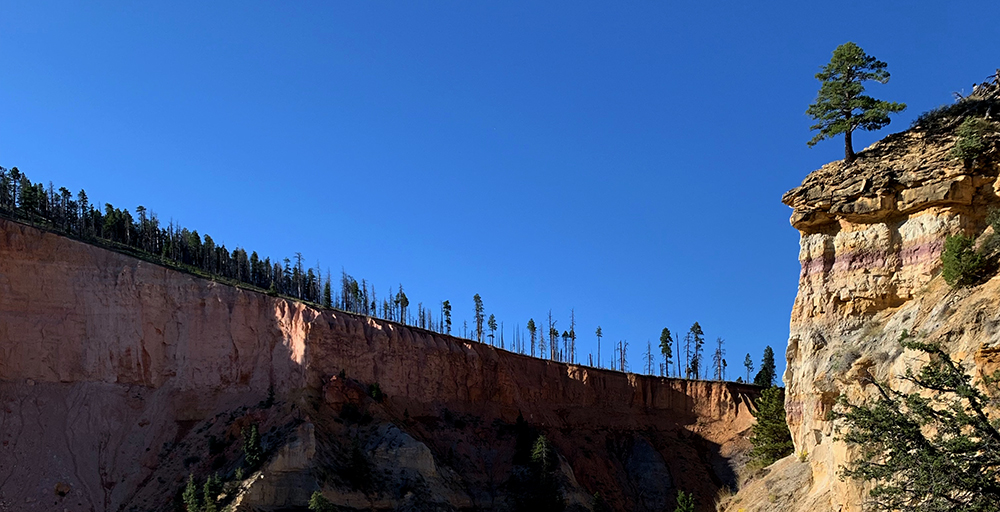
Getting a Permit
A quick stop at the visitor center and a $5 fee provided me with a permit to hike northbound from Rainbow Point to Bryce Point with two nights on the trail. There are eight campsites along this route, and you can choose any that you prefer.
I chose to hike from south to north because there is less elevation gain here as the hiker drops in from Rainbow Point, which sits at 9,115′ and exits at Bryce Point, which is 8,296′. The savvy adventurer avoids a substantial amount of uphill travel by hiking the Under the Rim Trail from the south to the north.
My itinerary was to camp the first night at Swamp Canyon, about half way through the trail. The second night was to be spent at the Right Fork of Yellow Creek, the closest camp to the exit at Bryce Point. I figured this camp was close enough to the exit that an early rousing would allow me to add the Peek-A-Boo Loop and the Navajo Loop to my effort and see some stellar hoodoos too. Also, I suspected that if I arose early and dropped into these trails right at sunrise, it was highly likely I’d have them all to myself.
The ranger at the backcountry desk warned me of e coli in water sources and insured I had a filter. He warned me of bears and asked if I had a bear-proof canister for food. (the park will provide one if you don’t have one) He also told me that there were likely some 120-150 trees down along the trail between Rainbow Point and the Right Fork of Swamp Canyon.
This would prove to be true…
Shuttle Options
The park offers a free shuttle service that runs from Ruby’s Inn (outside the park) as far into the park as Bryce Point. This shuttle runs continuously from 08:00 till 20:00 during the summer, and from 08:00 to 18:00 during the spring and fall. I was headed to Rainbow Point, about 20 miles further south of Bryce Point, so this would not work for me. Luckily, there was another option.
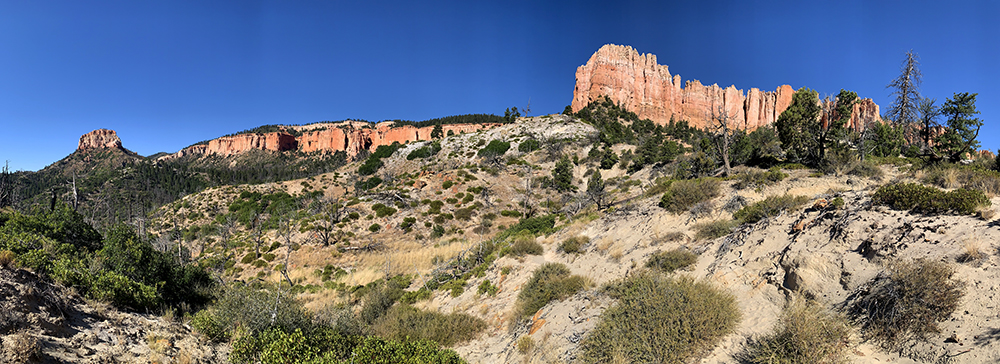
Bryce Canyon Shuttle Tours operates a tour that offers free shuttles to hikers to points south of Bryce Point. Reservations are required. The shuttle will pick up those without reservations on a space-available basis, but is often full.
Upon securing my permit, I headed out to the truck, and having cellular service, called Bryce Canyon Shuttle Tours to arrange a free shuttle for my trip. This is more of a tour than a shuttle, but it would work, so I was stoked. A bonus was that they offer a pickup at Bryce Canyon Lodge, which because I was adding the Peek-A-Boo and Navajo Loop to my itinerary, was right by my exit. Fabulous!
The tour operates twice daily during the summer season, departing at 09:00 and 13:30 from the Bryce Canyon Visitor Center. It is a great option for those hiking the Under the Rim Trail.
Park Creation
Bryce Canyon National Park was largely unknown to the outside world only a century ago. Local people in southern Utah had often heard of the peculiar landscape, but hardly anyone had actually seen it.
In 1915, a Forest Service supervisor named J.W. Humphrey was stationed in nearby Panguitch, Utah. One of his employees was familiar with the area and suggested that Humphrey go see “the eastern edge of the Paunsaugunt Plateau.”
Humphrey made the trip and upon his arrival at the rim, he was immediately impressed:
“You can perhaps imagine my surprise at the indescribably beauty that greeted us, and it was sundown before I could be dragged from the canyon view. You may be sure that I went back the next morning to see the canyon once more, and to plan in my mind how this attraction could be made accessible to the public.”
J.W. Humphrey – 1915

Humphrey sent photographs to Forest Service officials in Washington D.C. while also alerting leaders of the Union Pacific Railroad to the presence of another scenic wonder in southern Utah. The following year, Humphrey acquired a $50 appropriation to improve the road and make the park’s upper area to auto traffic.
Knowledge of the otherworldly scenery spread quickly back in the nation’s capital. In June of 1923, President Warren G. Harding named Bryce Canyon a national monument. The following year, Congress one-upped this and created Utah National Park. In 1928, the name of the park was changed and Bryce Canyon National Park was created.
Let’s Go!
After acquiring a permit and arranging my free shuttle, I headed southbound to park my rig, Frankie, at Rainbow Point. Driving through the meadows that hold the Paria Ski Loop, to the east of the road, I witnessed a lone Pronghorn strolling slowly across the meadow. I slowed and gazed out curiously toward this creature, the second fastest land mammal in the world.
Traveling southward, initially traffic did not seem daunting. However, at the parking area for Rainbow and Yovimpa Point, a line of more than 30 cars stood at dead-standstill. I resigned myself to just kick back and wait for the masses to filter through the lot ahead. Lest I forget, Bryce was the 12th most visited national park in 2018, with 2,679,478 visitors.
Essentially, none of these people ever venture into the backcountry. I just had to hold on to my sanity for another 30 minutes or so…
At last, I arrived, at the lot… a space with my truck, Frankie’s, name on it!
“This will be your home for the next two days.” I told my trusty metal chariot. (yes, I talk to my truck, who doesn’t?)
I grabbed my pack, tossed in a couple of last-minute additions, just to add some extra weight… Then I headed out to wade through the masses and beyond… into the wild.
On the Trail
A few camera toting tourists gawked at my pack as if it were a goiter and stood in awe. I quickly bolted past, desperate to evade that inevitable question of “where are you going?“…
Despite a significant wind, a perfect temperature of 76 degrees F made the day seem perfect as I skated onto the trail. An elevation of 9,115 feet provides a perfect hiking climate during the summer months. This makes Bryce a welcome destination for those looking to cool off after visits to nearby desert attractions.

Rainbow Point Departure
In quick fashion, I was on the move, headed down through a stand of burnt Ponderosa and Douglas fir. Switchbacks took me lower, through blackened remains of a once green forest. A beautiful pinkish ridge that lay in the distance. The obvious line of a trail that divided the ridge became apparent. Its allure invited my gaze to imagine the view from that point. I soon arrived and found a number of photographic pursuits.
I moved steadily downward, stopping often to take still more photos and numerous videos of the magical scenery unfolding around me. The burnt-out forest soon gave way to a healthy high desert environment. Green patches of manzanita dotted the red soil, which gave way to steep red cliffs just off the trail.

Ancient Great Basin Bristlecone Pines stand gnarled against the sky on high limestone knolls. These trees are among the oldest living creatures on Earth, with some more than 4,000 years old. They are testament to the rugged environment of the Paunsaugunt Plateau, upon whose eastern edge stand the cliffs of Bryce.
Numerous other trees find homes here. The Limber Pine, Ponderosa Pine, Douglas-fir and Blue Spruce are just a few of the residents in Bryce’s high-altitude forest. Such trees help form a unique habitat here that differs greatly from the surrounding Utah landscape.
As my trail descended into the park’s lower regions, the winds subsided and temperatures increased, although only slightly. I quickly found myself in a world quite different from that above. Familiar desert plants appeared such as Pinyon Pine, juniper and gamble oak, and of course, the desert classics: yucca and cactus.
Now below the rim, I began to look up into the cliffs, hundreds of feet above. The midday sun backlit the hoodoos, which mostly blended into the cliffs behind. Recessed areas of the cliffs where small canyons and drainages exit, offered views into the depth of the cliffs. These areas glowed orange as the sun illuminated them, while then cliff faces to the east stood drab, in a washout of light. The glowing openings were most intriguing, and recaptured my gaze from moment to moment.
The trail became a mix of red soil and rock, and provided relatively easy walking. The sand sections seemed short and not overbearing. A green carpet of manzanita lay divided by the red bark of Ponderosa Pines. The green of the forest stood backed by the pinkish red hue of the cliffs rising behind. A magic glow enveloped the park junkie.
Several streams exit the cliffs and descend to the east. Most are bone dry. Some have water flows that are several inches wide, and probably an inch or so deep. Not much water… but just enough… sometimes… Ranch land to the east of the park relies in part on water that flows through this area, but more than a century ago, a gentleman whose name you’ll recognized figured out a way to get more.
Ebenezer Bryce
In 1875, a Scottish-born Latter Day Saint named Ebenezer Bryce came here at the behest of the church to farm the Paria Valley just east of the park. He and his wife Mary originally settled in Clifton, which does not exist anymore. Soon they moved up into the Henderson Valley, and they worked much of the land in view from the upper parts of the Under the Rim Trail.
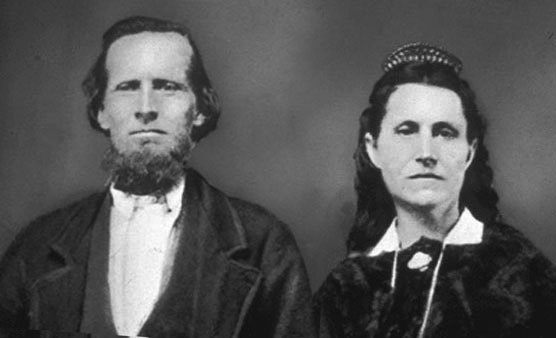
Mr. Bryce helped construct a 7-mile irrigation canal that provided water to barren fields. He also built a road high into the pink cliffs, in order to have better access to the rich timber that stood in the higher elevations. Bryce was a ship builder by trade, and was quite skilled with wood work. In fact, he constructed a church in the shape of a ship in Pine Valley, near St. George, Utah, just west of Zion. This church is recognized as the oldest continuously-used chapel in the Mormon faith.
Ebenezer Bryce was instrumental in creating the infrastructure crucial to the ranching enterprises that sprung up on what would one day become the park’s eastern edge. Folks soon began calling the land of the pinkish hued cliffs, Bryce’s Canyon. Although he and his wife left the area in 1880, the name stuck. His feelings toward the land are not widely known. He likely felt something when he gazed at the bizarre landscape, as he often must have done.
Today, the only widely known statement made by Mr. Bryce about his namesake national park is that it was “a helluva place to lose a cow”…
Back on the Trail…
The leaves on the Quaking Aspen trees quaked and fluttered furiously, although the breeze was now quite tranquil compared to above. Aspen trees are always so hyperactive… These trees are unique in that they share a common rootstock, meaning all of the trees in a grove are connected to the same root. If the age and size of their roots are measured, they can be among the oldest and largest living things on Earth. Stunning… Nature is cool.
I soon arrived at the Iron Springs Campsite. For those moving northbound, this is the first of the eight campsites along the Under the Rim Trail. The waters of Iron Springs can be filtered for drinking, but the water’s iron hue sure looks intimidating. I passed…
Continuing toward my chosen camp, I began to encounter a number of small obstacles.
This section of trail is rough. Well, not really rough… but it is kind of raw. Washes are spanned not by bridges, but by haphazardly placed logs. None of these sticks instill confidence in a safe crossing due to cracked and rotted sections. The fact that a simple step evoked a creaking sound familiar to horror film buffs reassured me that I’d be better suited to just take another route.
The next 6-8 miles contained hundreds of downed trees, many of whom fell victim to past wildfires. At one point, I came upon a nice landslide, which covered an estimated 40 feet of trail. This required a bit of scrambling, but nothing outrageous.
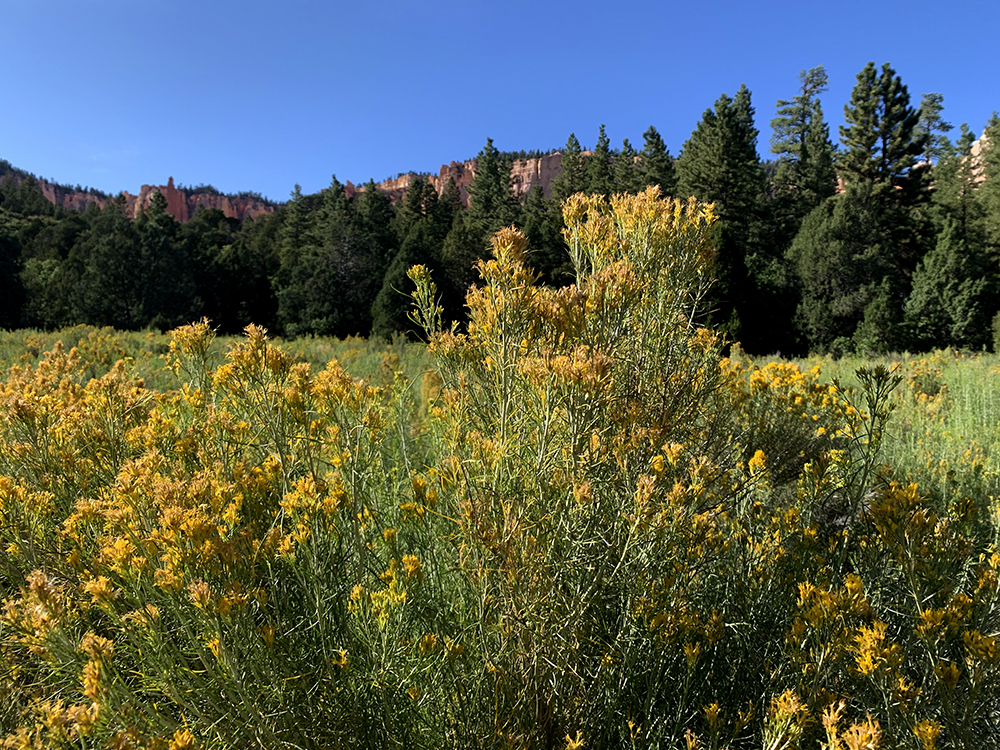
As the sun slowly descended behind the rising hoodoos and pink cliffs to the west, the ampitheater of Bryce began to glow. I soon came upon a meadow filled with yellow Rabbit Brush that waved placidly in a light breeze. I stopped and filmed the scene for a brief spell, contrasting the yellow against the red and pink behind, before continuing along the trail. So nice…
Tall dead skeletons of trees whose once thick bark was removed by fire stood proudly against the blue sky, their limbs outstretched toward the heavens. I stopped to admire the colorful grain in the trees body. Their naked core wore a most beautiful reddish hue at this time of day. I followed the lines of their grain upward to the as they wound around the trunk in a clockwise manner. This led me to wonder, do trees south of the equator’s grains grow in a counterclockwise manner…?
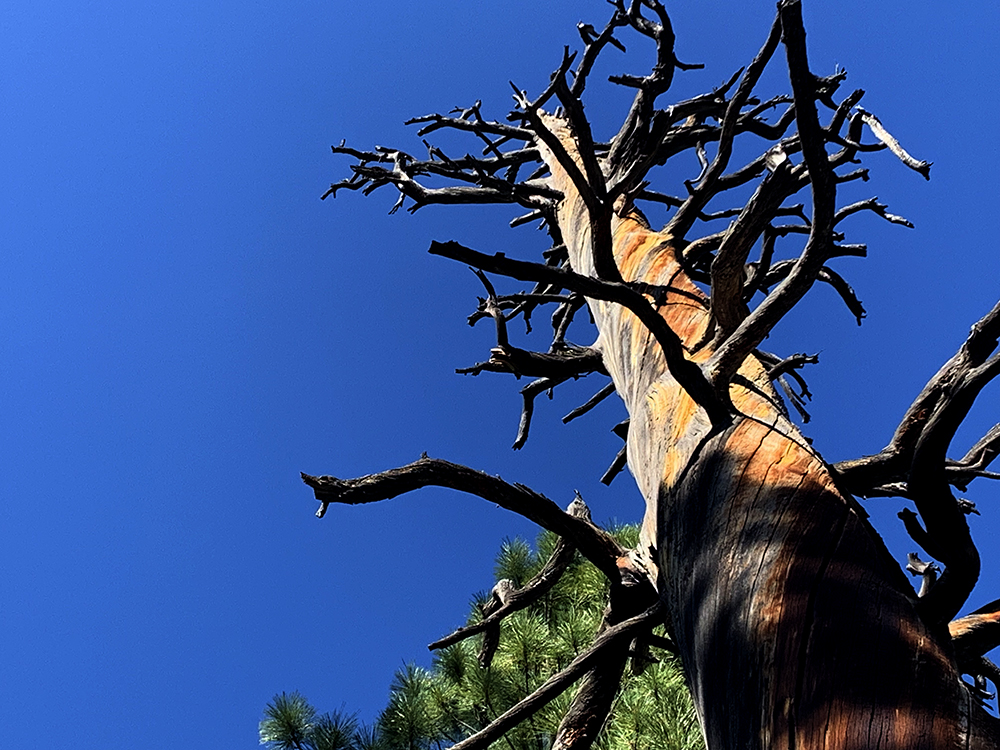
I passed the Agua Canyon connecting trail, which led back to the top of the cliffs and the masses of people above. It was closed… I don’t know why. These trails don’t see much traffic.
Soon after, I passed the Natural Bridge campsite, which lies directly below the Natural Bridge, which is a popular stop along the road where car-bound visitors mug for shots against the stunning backdrop to the east. Folks at this campsite enjoy the view from a much different angle.
The forest was quiet as I strode through the tall trees, the only sound being that of my feet as the crunched pine needles and small pebbles beneath. I climbed some switchbacks toward a pass that rose above with a fabulous view of a south-facing cliff that was basked in a golden-red glow.

I paused to glance at my map, knowing that my day was nearing its termination and that my campsite must be near. Sure enough, at the apex of this climb, I would descend slightly before entering what appeared to be slight incline toward my camp at Swamp Creek.
Continuing on, I passed through a section of trail that departs the park and re-enters perhaps a half mile later. The trail took on an ever-so-slight upward tilt as I crossed another 20 or 30 downed trees, fallen in a beautiful random pattern of natural organization. Greens glowed green and reds glowed red. To my east rose Noon Canyon Butte, bathing in the perfect light of a typical Bryce sunset.
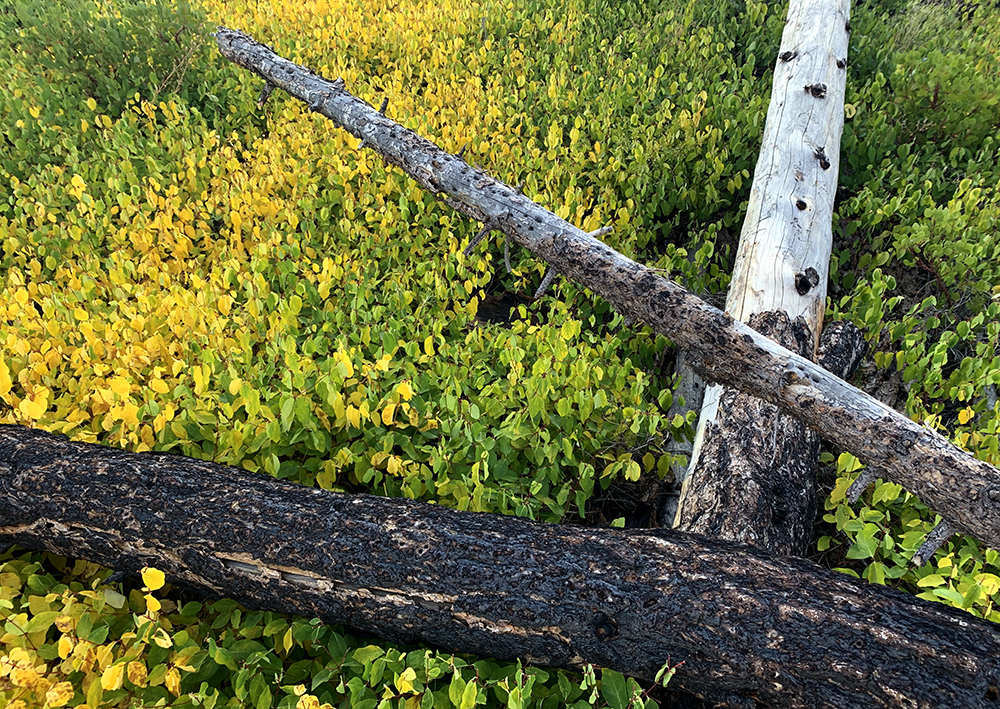
As I made my way onto a flattened section of a valley that seemed as if it tapered off to the east ahead, I knew my camp was afoot. Within ten minutes, a fantastic view opened to the east, with reddish pink cliffs falling sharply from a cliff whose treed meadow ended quite abruptly at its northern edge.
I came upon the Whiteman Connecting Trail, and the Swamp Canyon campsite, some 50 feet beyond. Home sweet home… I had just hiked somewhere in the neighborhood of 11 miles… and had not seen a single soul since the parking lot at Rainbow Point! Gotta love that!
Swamp Canyon Campsite
I removed my pack, to experience that floating feeling that only a backpacker knows upon discarding his burden. It is kind of like levitating, as the weight of one’s world is immediately gone and he feels so much lighter, almost as if he is so light he could fly.
I flew into the evening chores: erecting a tent, pumping up my sleeping pad, tossing the sleeping bag into the perfect position, and preparing a dinner fit for a king… Ah, Tasty Bites with summer sausage. Taking a perfectly good vegetarian meal… and making it more perfect…
While dinner was preparing, I took the opportunity to set a time-lapse of the sun setting on Mud Canyon Butte, and Swamp Canyon Butte, both of which were positioned just to my northeast. I enjoyed dinner, and did my dishes (none), then topped off my feast with a chocolate bar and a nice swallow of water to wash it down.
I had become somewhat concerned with my water supply. There were a couple of sources available earlier in my day, but I had continued on without adding to my reservoir because I just hadn’t used much at that point. As I continued I had drank more and more of course, but hadn’t crossed a good source for miles. So I was suspect and resolved to use a minimal amount with dinner. Luckily, my choice of meals requires no added water, and I could reuse the boiled water that heats my meal.
I was sure there was water ahead at some point, but the ranger had been reticent to tell me for certain that there was water in any of the given sites ahead. He had, however, warned me that Yellow Creek, which I would pass the next day, had tested positive for E Coli… so I had that in my pocket…
I went for a brief stroll before bed while the time-lapse continued. I crept along the rim of Swamp Creek, that drops off just to the north of the camp. Stopping to listen, a delightful sound was heard… running water!
I cocked my head to gain a more accurate recording of the sound, to make sure I wasn’t trippin… Yep water! The small Swamp Creek had a small flow to it, and this would be sufficient to supply my filter for the following day’s trek. Relieved, I returned to camp, laid down in my tent to examine the map. I waited patiently for darkness to envelope my world so I could grab my iPhone, which was capturing what I felt positive would be an epic sunset.
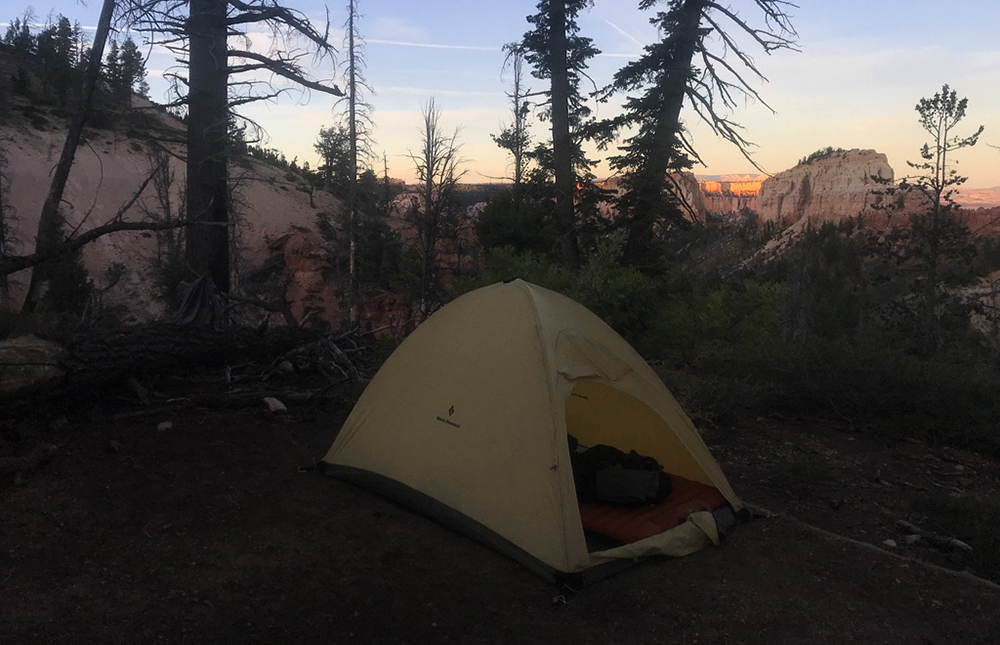
Park junkie can stare at a map for hours, processing the finely detailed contour lines of a beautiful topographic map…. I stared and stared…. Read the park descriptions and geologic facts that such maps occasionally include… Finally, darkness…
I emerged from my tent, grabbed the iPhone and returned to my dwelling, eager to press play, and witness my filmmaking skill…
Play: sun sets, camera re-adjusts exposure… gets darker… camera re-adjusts exposure… gets darker…. camera readjusts… Well shit…
Back to the iPhone learning curve… I suppose you have to set the auto lock focus/exposure…. Okay… Damnit… Off to sleep now…
Relaxing….I quickly fell into a nice slumber…
Soon however, I was awakened by the soft murmur of voices… What? Yes, voices in the wilderness. A European accent, the language of which I was unsure.
They were cogniscent of my presence and were quite respectful, whispering and moving about with care. I was thankful… and rolled over to return to my dreams of flying cars and puppies with horns and glowing eyes on merry-go-rounds.
Day Two
Somehow, sleep was not to be an enjoyable affair that night. I awoke at some point around 01:00 to a flat sleeping pad… quite a bummer. I went outside to relieve myself, and returned to pump the pad up again. After this process, which only takes a couple of minutes thanks to a foot pump embedded in the pad, I returned to my position of rest. I tossed and turned until sometime around 04:00 before I returned to an unconscious state. At 07:00, I awoke, to find my sleeping pad had flattened again. Quite frustrating….
I laid around for a few, then sprung into action, not quite rested from my evening of first -world struggles. I went about breaking down camp quietly, as my neighbors had not yet risen. After camp was broken down, I fixed a delicious breakfast of Tasty Bites, although this time with smoked salmon, and packed up to hit the trail.
My neighbors had made their way out of their tents by this point. A nice European family who had hiked down the Whiteman Connecting Trail, which leads directly to the Swamp Canyon campsite, just to get an evening in the backcountry. They were headed right back up the same trail, back to their car. They hiked a total of 100 feet on the Under the Rim Trail… like I said, this trail doesn’t see much traffic.
Moving out of camp was a slow affair, as I was a bit sluggish, but the trail soon revived my senses and I stopped to filter some water at Swamp Creek. A small flow proved adequate to fill my Camelback and my Kleen Kanteen. After a quick hike up into the woods to relieve myself of a morning urge, I resumed my northernly course up Swamp Canyon toward the Right Fork. I would continue northward and camp tonight at the Right Fork of Yellow Creek, just below a feature known as the Hat Shop.
This stretch of trail was beautiful, passing through a large grove of dead trees, backed by the morning glow of the red cliffs to the west. I hiked past Mud Canyon Butte and Swamp Canyon Butte, which at this hour provided shade for my passage.
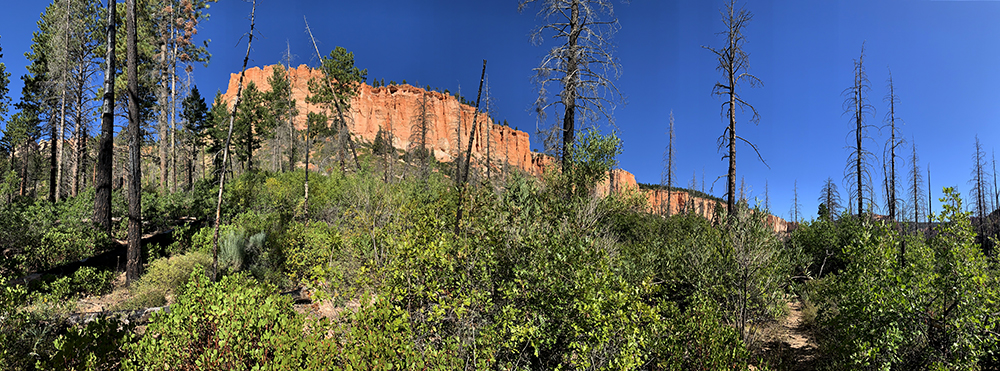
I arrived at the Right Fork shortly and continued north, up a small incline that allowed fabulous views of the cliffs to the north. Soon, I found myself hiking through a slightly thicker forest, on a trail that seemed much more well traveled.
The trail leads to the east at this point, moving around an area of the Puansaugunt Plateau that juts out into this region. Large reddish pink cliffs line the route to the north and the trail skirts their southern edge, giving a fine view of these rarely seen wonders. Occasionally, towering red monoliths poke above the cliffs, showcasing the great variance in the plateau’s topography.
Geology of Bryce Canyon
As I strolled along this section of the trail, with its up-close proximity to the cliffs above, I began to recollect my readings from the previous night’s map examination.
This area of southern Utah is encompassed by a larger area of the American Southwest known as the Colorado Plateau. This massive plateau stretches from its western termination near the Grand Canyon and Zion, all the way into south-central Colorado. It covers more than 130,000 square miles and was the result of a geologic uplift some 15-20 million years ago. It is comprised largely of sandstone. Much of this rock is comprised of grains of sand which washed and blew westward over tens of millions of years. These sands came from the Appalachian Mountains, which once rose to massive heights on the continent’s eastern side.
Within the bounds of the Colorado Plateau, endless amazing scenes are found. Many areas here enjoy national park status, or some related form of public protection. Practically the entire section of Utah south of I70 is protected by some state or federal agency, all the way to the state boundary with Arizona.
The western section of this area includes Bryce Canyon National Park, Zion National Park, and the Grand Canyon National Park. More than simply pretty places, these landmarks are known in the geologic world to comprise the western cornerstones of an area called the Grand Staircase.
The Grand Staircase comprises a large swath of southern Utah and a part of northwestern Arizona. It is an area in which a large sequence of sedimentary rock layers lead downward in elevation, from Bryce Canyon down into Zion, and further down, into the depths of the Grand Canyon. Scientifically speaking, this is the most well-preserved geologic storybook found anywhere on Earth!

Image courtesy of : Public Domain, https://commons.wikimedia.org/w/index.php?curid=314356
Named in the 1870s by geologist Clarence Dutton, who divided the region into 5 layers, this area is now is known to hold more than 20 layers of individually named stone formations. These stratifications in the Earth’s outer region’s offer clues to some 550 million years of geologic history!
The Grand Staircase is unique in that most of these layers are easily observable here today. No place else on the planet provides a more complete listing of the chapters of the Earth’s history. In most places, the book of geologic history is damaged, much like an abused library book. It is missing chapters that were torn out by deviant glaciers, or erased by those pesky mountain building events. Some pages have been removed, only to be rolled with some illicit substance and smoked in the bathroom by a wayward volcano…
The course of geologic history is often incomplete due to the simple passage of millions of years. Yet the region of the Grand Staircase stands largely unaffected by the common destroyers of such history.
Each layer is significantly different, but water has played a part in each area’s erosion. It is easy to see the effects of water at the Grand Canyon and Zion. It is obvious to the common visitor that these great canyons were carved by water, although it may seem somewhat unbelievable given the massive scope of these areas.
But what the hell happened at Bryce…?
A delicate balance of time, temperature fluctuation, and soil composition provide the perfect elements for a process scientists call “frost wedging” to work magic on the land.
At the top of the Grand Staircase is our Bryce Canyon National Park, standing at the eastern edge of the Paunsaugunt Plateau. Here, at the height of 9,150 feet we find the top layer in Dutton’s Grand Staircase, the Claron Layer. The heightened elevation here means that this place is affected by a drastically different climate than the lower areas of the Grand Canyon, at a mere 2,600 feet.
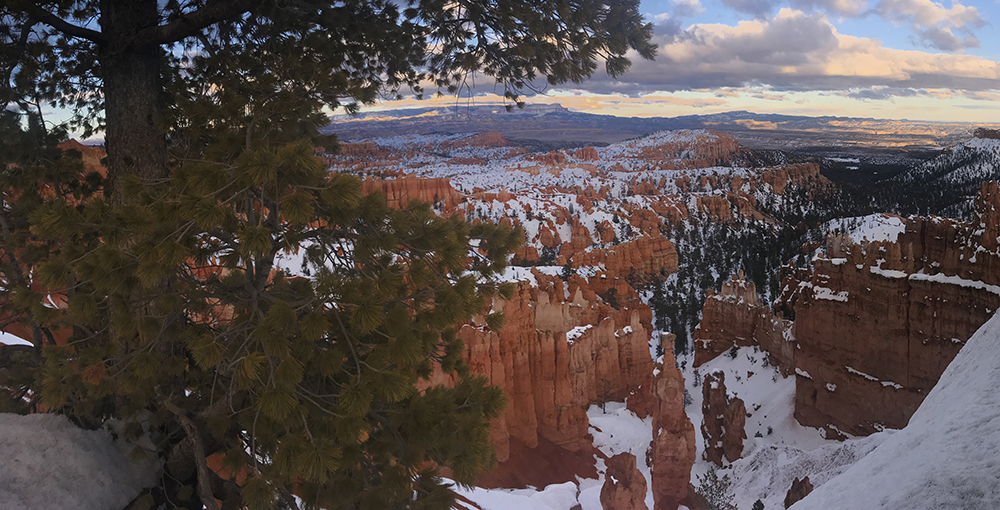
Bryce sees a wide range of temperatures at this elevation, and winter nights are downright harsh. The park receives a great amount of snow, and more precipitation than surrounding areas. In the winter of 2018/19, the park was blanketed with more than 11 feet of the white stuff, effectively removing it from a drought that had lasted for nearly four years.
Let’s not forget the fact that this is still part of the desert southwest, a land of sunny days with nary a cloud. This means that Bryce has bone chilling frosty nights, and warm sunny days that provide great amounts of heat for creatures who wish to lie on the rocks, which absorb this heat. The park witnesses more than 200 freeze/thaw cycles per year.
The effect of this temperature fluctuation is severe. Water that seeps down into cracks along the edges of the Paunsaugunt Plateau is frozen at night. Frozen water expands by some 10% its size. This slowly creates and widens cracks that form in what eventually become cliffs.

These cliffs are comprised of mudstone, siltstone and largely, sedimentary limestone. All of these rock formations are weak compared to other types of rock. The water freezes and expands, only to melt then following morning, then freeze and expand the following night… then melt… then freeze and expand the next night… and the next…
For tens of millions of years… Yes, you’re beginning to get it huh?
Rocks are broken… Openings enlarge… Walls are eroded… Stronger layers of rock remain… Weaker layers fall away… Windows form… Windows collapse… Debris falls hundreds of feet. It will be washed away by rains… The cliffs erode further into the plateau…
Scientists estimate that these cliffs will eat their way through to the west side of the Paunsaugunt Plateau within 300 million years… So you better go now.
Back on the Trail…
I found myself winding through Ponderosa pines and the red soil lay littered with cactus and manzanita bushes that glowed bright green in the mid-morning sun. A fantastic day was unfolding and I was eager to get some miles under my belt.
I moved eastward along the trail. Just prior to the Sheep Creek Connector Trail, I noticed people in the distance. These were the first people that I had encountered on the actual trail since I left the parking lot, some 13 miles back.
These folks were day hikers who had came down the Sheep Creek Trail and planned to head back up the Right Fork Swamp Canyon Trail. They were somewhat older, but still going for it. We talked for a spell, as you sometimes do when you’re actually out there. These fine folk, Sharon and Dennis, told me that they were from Virginia. They had hiked more than 1,700 miles of the Appalachian Trail. They were hoping to complete it before they got too old. I loved it. Nice work ya’ll.
As I just noted, I often find myself actually talking to people, and enjoying them, on the trail in the more remote backcountry. Conversely, I most often avoid them like zombies when in the more congested areas of the trail. Just overload I guess. And perhaps respect for those who get out there…
This stretch of trail held a few hogsbacks over which I had to climb. These involved an ascent of some 300-400 feet. A little uphill, but usually in short stretches. The trail is quite nice through here. It is well-traveled and there are no downed trees to climb over. This elevation provides a nice workout for the legs and lungs.

I topped out on one of these ridges and took a break for lunch. I broke out an apple and ate it. Then I busted out a nice chocolate energy bar thingy. I stared at my surroundings. I stared at my map. Then stared at my surroundings again. Where the hell am I….? Ah, there, on that lil ridgeline right there…
Looking back to the south, I could still see Rainbow Point and the ridge that I descended to the east the day before. The landscape revealed my route, which led in a series of horseshoe shaped cirques as I followed the contour of the cliff. I looked to the north. Yellow Creek lay just over the next ridge. Let’s go…
More beautiful pink cliffs rose before me to the west. More trees and desert shrubs lay before me along the sandy section of trail that I found myself descending. I moved somewhat slowly. The previous night’s lack of sound sleep was catching up with me. I just kept rolling, planning to maybe take a nice break at the Yellow Creek Camp, which lay within striking distance.
Birds sang me songs as I made my way into the forest below. I paused just to listen to the wind in the limbs of the tall Ponderosas for a few minutes… It was perfect.

I moved around the eastern point of a small ridge and turned back to the west to descend into the next horseshoe shaped amphitheater…
Bam! Another stellar view! This one home to Yellow Creek and a stunning array of hoodoo-laden cliffs that seemed to hold an ancient secret. Perhaps they do…
Native People
The ancestors to the Paiute Indians, occupied this area beginning around 1200 A.D. They used the land for hunting and gathering activities. There is no evidence of native settlements in the immediate Bryce area.
The natives observed what we know today as Bryce with a great curiosity and respect. A Paiute elder, Indian Dick, explained the legend of this area to a park service naturalist in 1936.
“Before there were any Indians, the Legend People, To-when-an-ung-wa, lived in that place. There were many of them. They were of many kinds – birds, animals, lizards and such things, but they looked like people. They were not people. They had power to make themselves look that way. For some reason the Legend People in that place were bad; they did something that was not good, perhaps a fight, perhaps they stole something… the tale is not clear at this point. Because they were bad, Coyote turned them all into rocks. You can see them in that place now all turned into rocks; some standing in rows, some sitting down, some holding onto others. You can see their faces, with paint on them just as they were before they became rocks.The name of that place is Angka-ku-wass-a-wits (red painted faces). This is the story the people tell.”
Indian Dick – 1936
Back on the Trail…
As I dropped into the Yellow Creek basin, I saw a nice meadow below, which beckoned my presence. I moved downward, considering what the view might look like from such a tranquil place.
I noticed an approaching hiker rapidly approaching from below. A lone fellow with a couple of trekking poles and large friendly smile wasted no time in ascending the trail. He & I chatted for a few. He was hiking from Bryce Point to the Right Fork of Swamp Canyon, and back up to the main road. A nice day hike for sure! I bade him well and disappeared into the forest below in search of my meadow.

I made my way to the Yellow Creek Campsite, which I will report was my favorite of the eight sites along the trail. There is a flowing creek beside the camp, and it is yellow. The ranger at the VC, and a sign posted at the camp’s entrance warned of E Coli here. Being in need of water, I filtered a canteen’s worth anyway, but did not add it to my camelback. This water could be boiled later if needed. Filtering alone is not sufficient to remove all risk of E Coli contamination, but a 3 minute boil and a filter will do the trick.
I laid around the campsite on a log, relaxing… Staring at the cliffs… Staring at my map… Enjoying the breeze and the sound of running water in the wilderness…
I considered staying here for the night, it was so nice. But knew that I should move on to lessen the miles remaining the following morning. I laid around some more…
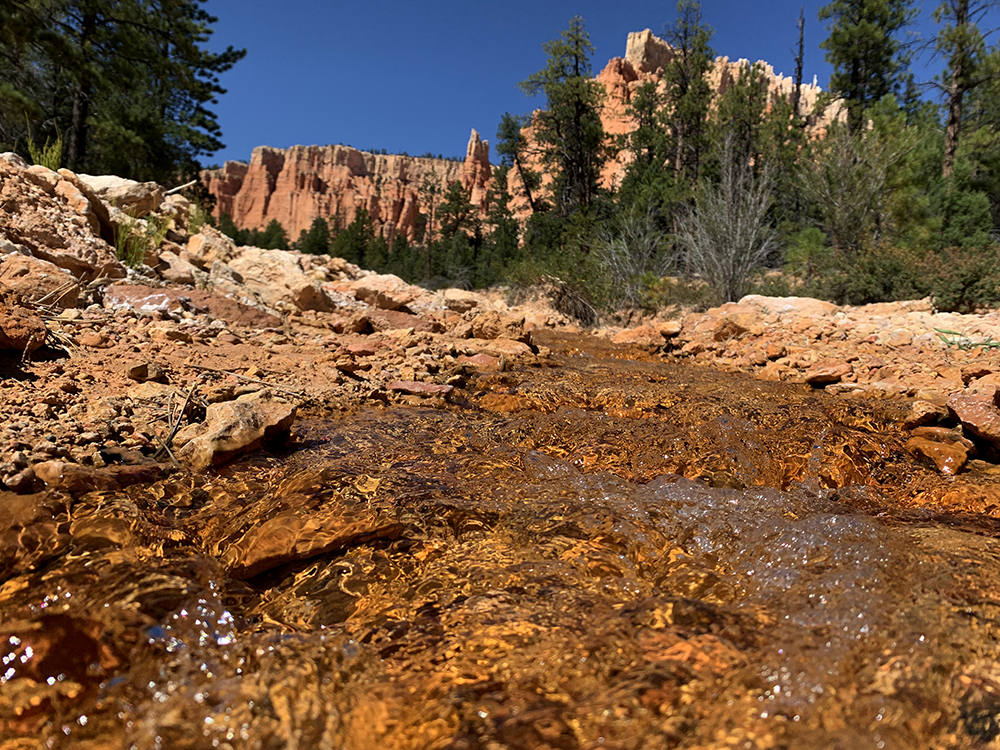
Finally, I arose and set out to find that meadow that I had noticed from above. What would cause such a feature to form in an otherwise wooded basin? I would find out…
I headed upstream from camp, walking beside the flowing yellow water. It was gorgeous against the pink hue of the creek-bed, which was about 30 times wider than the stream that currently flowed through it. During storms, this must be quite a scene.
It did not take long at all to reach the source of the water, listed on the map as Yellow Spring. In fact, Yellow Spring, it turned out, was the meadow that I had witnessed from above. Strange… The water just flowed right out of the grass beside the creek. It was quite a small flow, but it was steady and constant. I climbed up to the bank of the stream and stole a few panoramic photos of this scene, which I found soothing.

I enjoyed the view for a time, then headed back down the stream to the camp and my pack. More miles to put in today. But only a few. Three miles between me and the Right Fork Camp. Let’s roll…
A Close Encounter
I made my way quickly along the trail, which cut through a thickly forested canyon as it continued east. I was clicking right along when out of nowhere came a sound that stops all hikers in their tracks, or sends them springing a few feet into the air… The sudden high frequency thrashing of a rattle… the demon of the desert! The rattlesnake!
I instantly located the direction of the source of this sound and immediately determined that I was indeed safely past his striking distance. Whew….!
I peered into the brush, and there he was… coiled up and in the fighting stance. His rattle was going mad and his tongue flicking up and down in the air. The serpent acutely assessed his situation while alerting me that I didn’t want none… He was right. I wanted no static from this guy. I examined him from my safe haven of several feet away for a minute and then bailed out… Let’s roll…
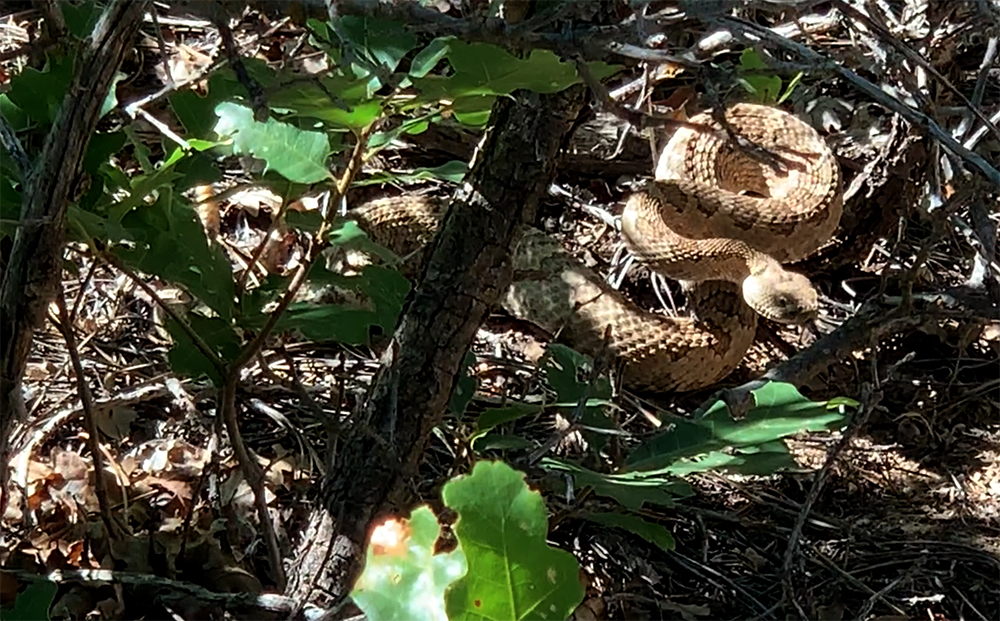
I respect that… Thank you.
I made quick moves again, headed for my cozy lil camp. After passing the Yellow Creek Group Campsite, the trail opened up into a typical open desert scene for about a quarter of a mile before popping back into a canyon, the beginning of the Right Fork of Yellow Creek.
I made good progress here, knowing that camp was close at hand. The sun was still well above the cliffs to the west, but I wanted to get in early, as to set up camp, cook, filter some water and boil it, and head up to the Hat Shop for sunset. I wanted another shot at that damned time lapse.
Right Fork of Yellow Creek Campsite
Soon I arrived at my destination. After setting up camp, I examined my sleeping pad and cleaned the air ports of any potential debris which could cause a leak in hopes of getting a full night’s sleep without the discomfort of a deflated pad. I cooked a quick meal and boiled more water.
My campsite was wooded and shaded. There is a small flow of water at this site, although the warning of E Coli presence is posted here as well. There is space for perhaps 4 or maybe 5 tents here. It is a cozy camp and the sound of running water is always a bonus when considering a night’s sleep as far as park junkie is concerned.
After a brief chill session, I headed up the trail toward the Hat Shop to witness the setting sun.
The wind had picked up, and setting up the ol iPhone on the worthless little tripod that I use proved impossible. I found a nice little bush whose lower limb had been broken off by something. The limb was still sturdy, and made a perfect down presser for the top of the tripod. I tucked it right under there, set the camera in motion, applied the auto lock function, and found a nearby rock upon which to enjoy the show.
A hiker soon came into my view, quickly making his way down the trail, right across the top of the Hat Shop. He paused here and there for a photo, but seemed bent on making his way down to camp. Onward he marched, seemingly unaware of my distant presence.
I grew bored laying around, so i grabbed my other iPhone and headed to the top of the Hat Shop to and just lounged around enjoying the silence and solitude. After an hour or so, the sun disappeared. Time for bed. The morning would come early and I had a date with my alarm at 05:00 am.
I strolled into camp just before it really got dark to find that I had a new neighbor, whose name was Pete. He was set up for success and was getting ready to go on an evening stroll in the remaining moonlight. The full moon had passed some 4 days earlier, but the night glow was still sufficient for an evening exploration. We chatted briefly. I told him a bit about Zion, which was his next destination. Then I wished him well, and laid down my weary head and about 20:45.
Day Three
I awoke before my alarm at 4:51, my pad still fully inflated! I had enjoyed a full sleep and felt alive and ready to roll… Ah, the great outdoors!
I quietly packed up my belongings and ate a morning snack. Then I woke Pete, who had asked for a wake-up-call. I made my way onto the trail, and turned off my headlamp. I prefer to hike in the moonlight, or even starlight, when possible. It was 05:35 in the am.
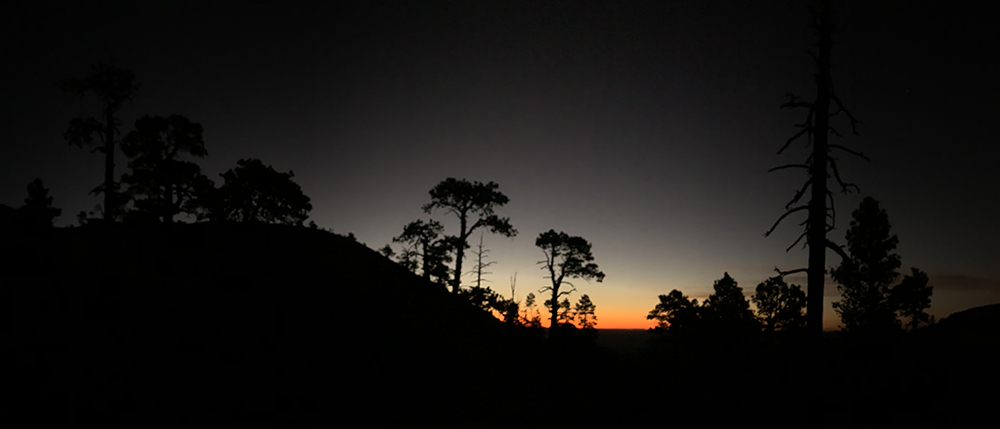
The morning was brisk and beautiful. The cliffs glowed grey in the moonlight as I ascended the few hundred feet to the top of the Hat Shop. Here I was greeted by a small number of lights from the nearby town of Tropic, which lies just to the northeast of the park. There must have been at least 20 or 30 lights down there. That’s town out in these parts.
A faint glow arose in the east… I moved quicker. Staring at the map the day before, I had decided that I would hike up to Bryce Point. Then, instead of hiking the Rim Trail to the Bryce Canyon Lodge, I would descend back down to the Peek-A-Boo loop. From here, I would make my way onto the Navajo Loop before hiking back up through the Wall Street area, past the Silent City. If I was there early enough, I could complete this route and probably not see many people.
Light increased, so did my pace. Upward I moved with a purpose. The cliffs began to glow in an awesome reddish light, the type you just don’t see outside of canyon country. The southwest has its own red you know…. If you haven’t been here at sunrise or sunset, you just have no idea.
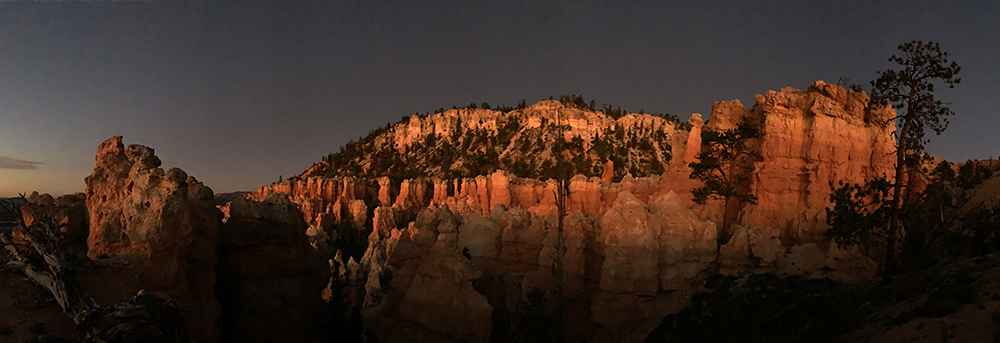
I began to pause here and there for photos and videos. The scene was just too amazing to ignore! There are colors at this time of day that simply don’t exist during other times.
Continuing upward, it was not long before I topped out at the intersection with the connecting trail that led down to the Peek-A-Boo loop. The sun was just rising above the ridglines in the east. Light was direct, and perfect! It was 07:14…
Peek-a-Boo Loop
I moved downward as if a child descending into a massive sandbox with cliffs of chocolate cookies all around… It was the best sunrise I’ve seen in years. Not a soul in sight, not a one… Just the To-when-an-ung-wa… and myself.
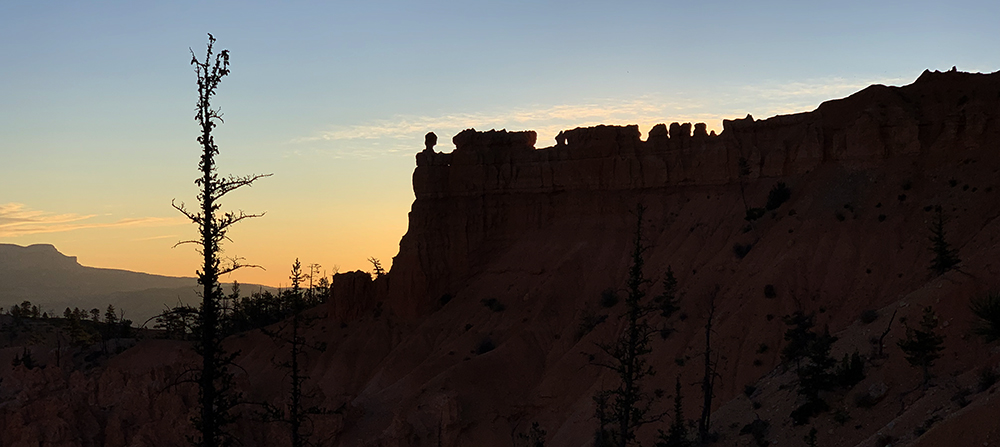
My head spun in circles as I made my way through what I consider one of the most magical landscapes on Earth!
Hoodoos
Hoodoos are special features. They are found in many places in our wonderful world. There are hoodoos throughout the bizarre landscapes of southern Utah. Quite a number exist in the northern Great Plains of the Dakotas in places such as Badlands National Park and Theodore Roosevelt National Park. There are likely numerous areas in the middle east where such structures are not out-of-place.
However, nowhere else on Earth is there are larger, more grandiose collection of these astounding towers of dirt and rock than right here in the northern realm of Bryce Canyon National Park. For hoodoos, this is it…
Back on the Trail…
I roamed about in awe for some time, taking photos of this structure and that. After setting up a few videos I made my way further down the trail.
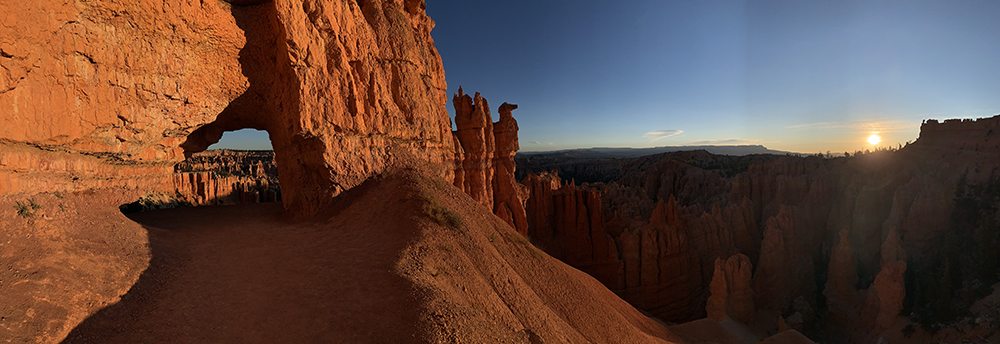
Soon, I reached a junction with another trail. But this seemed strange… It said Peek-A-Boo and had an arrow pointing in each direction. I was already on the Peek-A-Boo trail right? WTF? This sign should have an arrow to the east, and indicate that the Navajo Loop was perhaps a tenth-of-a-mile in that direction. I should be able to see it… Strange.
I headed down to the right, wondering why my map was not accurate. This should have been a warning sign right there… I hiked down the trail for what seemed a quarter-of-a-mile, then told myself this couldn’t be right, and headed back up the trail, to the junction from which I had just came.
Back at the junction, I scratched my head and looked at my folded map, whose contour lines didn’t match the surrounding area in any way whatsoever. I assured myself that the map was a piece of shit, and strolled off in the other direction, somewhat certain that I’d find a place where the trail intersected the Navajo Loop.
The time was 08:00. With one hour and 15 minutes to make my way to the lodge, I was not too worried, but was aware of my limitation.
I cruised up the other direction on what the sign told me was the Peek-A-Boo loop, uncertain as to why it was definitely not following the route indicated upon my map.
“This is bullshit”, I muttered to myself.
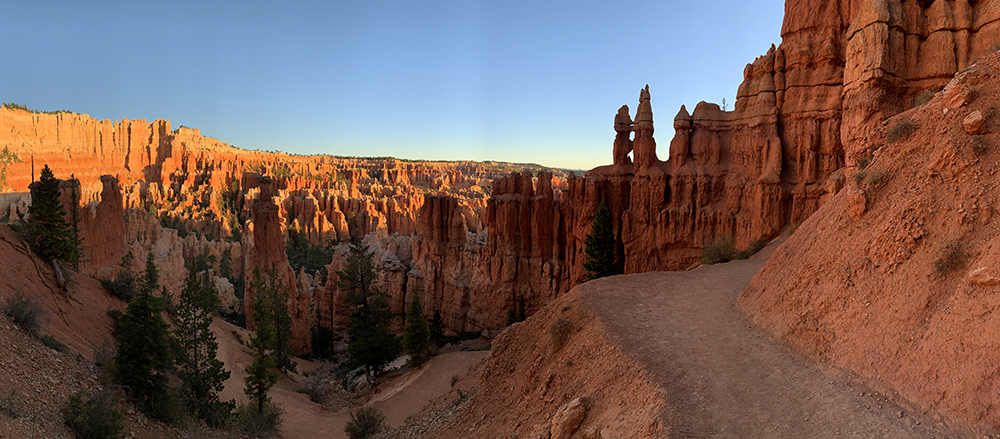
I continued on, sure that the Navajo Loop was somewhere below me, but found no sign of it. So effing weird… Time was ticking. I could now hear it.
I went on for some ways here, uncertain as to what was going on. Perhaps the To-when-an-ung-wa were responsible for this… I had still not seen another person this morning.
It was 08:20.
This would not be a problem, as it was only .2 + .4 + .5 to the Lodge, if I was at the junction of the Navajo Loop. But where the hell was I? This must be some sort of joke…
I continued on, before eventually determining that I must be headed back up the western side of the Peek-A-Boo trail, back toward where I came… So, I turned around and headed back to the junction where I had initially became unsure of my direction.
I arrived back at the strange junction and pulled out my map again. WTF!!!!? I stared at the map for a minute and then it hit me… I was at the beginning of the Peek-A-Boo loop! It was 1.3 miles on the east side and 1.7 on the west side, and there was a 1 mile connecting trail that I had hiked to descend to this point! I was at the end of that one mile connector, not at the end of the Peek-A-Boo loop! Doh!
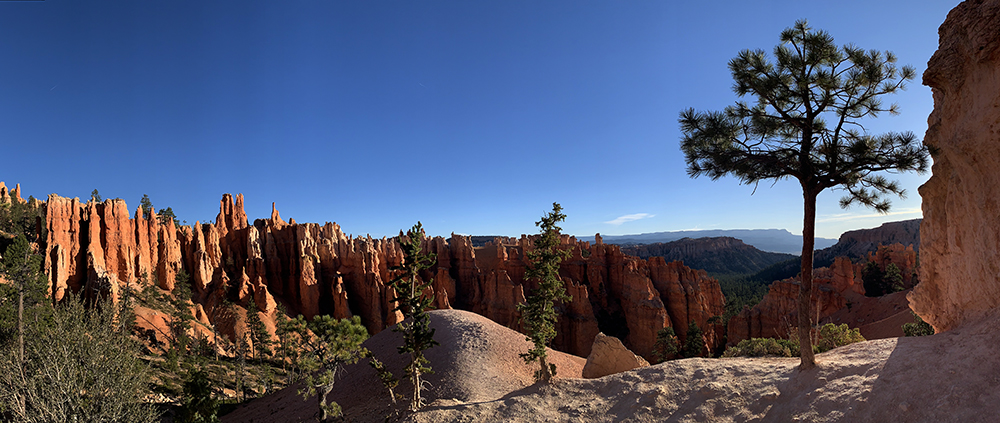
Damnit! Who was in charge of this circus!?! It all became immediately clear, and I looked at my iPhone to see the time… 08:43… I had 32 minutes to cover the 1.3 + .2 + .4 + .5 to the lodge. Quick math told me that I had 2.4 miles to travel in 32 minutes, uphill with a large pack… Not impossible I told myself! LET’S ROLL!
I took off at a run, jogging along like a man on a mission… Hell, I was on a mission!
Park Junkie Falters
I have not been having the best of luck with scheduled pickups as of late. A month ago, I missed my departing boat from Isle Royale National Park due to a time change error in my errant brain.
This turned out to be an epic problem, because storms were coming in the next day, and the Voyaguer II was full for the next week. The owner of the company, who I spoke with over the phone from the Rock Harbor Ranger Station, informed me that it may be up to two weeks before he could guarantee me passage on his boat to Grand Portage Minnesota due to possible weather… and the sea planes were full for the foreseeable future.
I luckily met some really cool fishermen at the dock at Rock Harbor. Their captain, a fine chap named Mike, accepted my stow-away status and his dad, an even finer chap named Mike, fed me beers the entire way back to Minnesota’s Grand Portage. Sometimes these sort of things just work themselves out…
Back on the Trail…
I moved along at a feverish pace, I could do it… This section of trail was meandering on contour through incredible terrain, but no time for that now! I jogged on. And then… it happened…
That’s right. I encountered the dreaded horseback tour…. NOOOOOOOO
Yep…
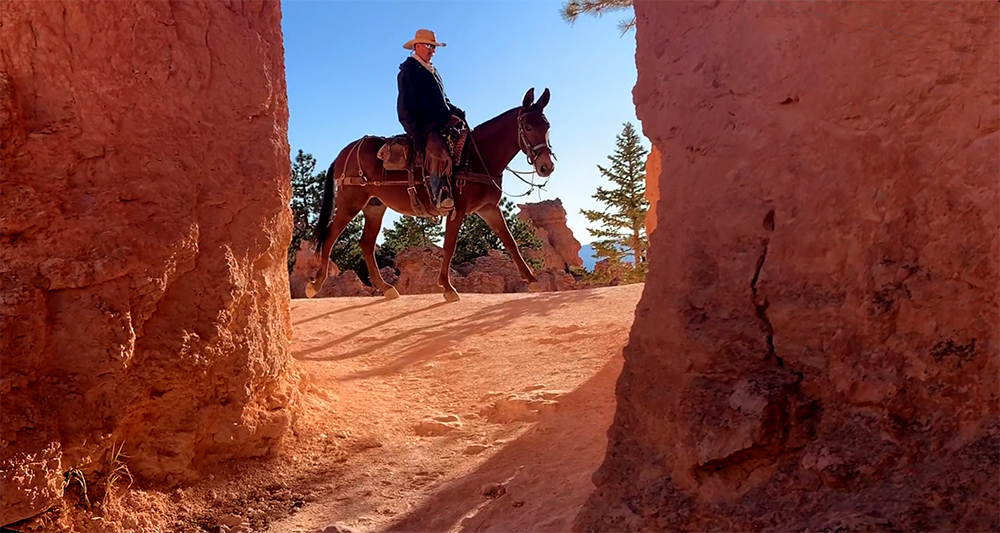
Peek-A-Boo is a horse tour trail. Not only does this mean you must watch your step, it means that you must step aside when encountering the train of horses. Horses become spooked and hikers are good at spooking horses. So this is the rule…
I had not seen a soul all morning, and now I was forced to stop, and wait beside the trail as a train of 12 horses and their sometimes slightly overweight riders clippity clopped right by with cheery greetings of “hello”, “mornin”, and “howdy”….
Finally the last horse passed, now I really need to speed it up…
I ran up a section of rock and passed the first of a slew of hikers that would be encountered from here to the top. I approached what would normally be a super cool tunnel through a rock and began to pull my camera for a selfie video of me running through the tunnel when I heard another sound that evoked a cringe from my soul….
“Hiiiidddeeeeoo…. Whooooddddeeeeeoooooo…. Hooooeeeeee….. Hoooooollllllllywooooooddddd……”
Another horse train…
Hope vanished. It was 08:48… & I was still not to the end of the Peek-A-Boo trail…
As the last horse passed, it dropped a load of excrement on the trail right beside me, as if to punctuate my journey with a proper mark…
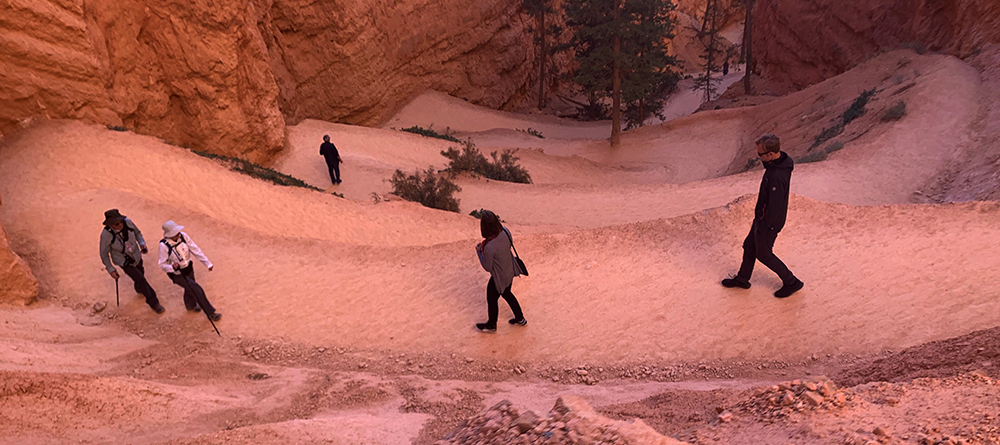
Not one to give up, I began running again. I passed people who looked at me as if I was absolutely bonkers. I approached a couple of very attractive ladies who took note of my pace…
“Training day…” I winked as I sputtered by in near life support status…
“You’re doing great!” one of them exclaimed…
If you only knew…
Soon I arrived at the junction with the Navajo Loop. I moved with purpose… Upward!
By this point, there were a good number of people on the trail. I kept a good slow jog pace, but as I entered the upper switchbacks, just below an area known as Wall Street, I had to stop and walk… Too much… I must walk…
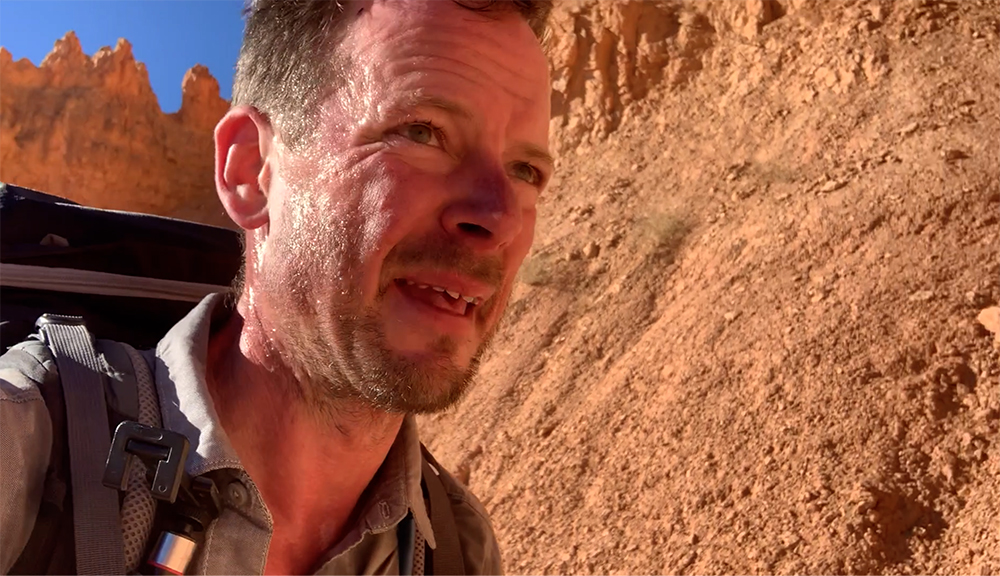
The morning breeze and the temp were perfect, but it was a significant elevation increase from the bottom up with my pack. I began to realize my effort was futile. It was 09:12…
Hundreds of people were gathered near the top of the trail, posing for photos with umbrellas and sneakers. One guy had a pipe in his mouth and wore penny loafers with a cardigan sweater… No joke. It was a real show up here and it only got better the closer to I got to the parking lot…
I made the railings at Sunset Point at 09:17… and I still had some distance to the lodge, but I could see it. So I kept going…
I got to the Bryce Canyon Lodge at 09:20… Park junkie was five minutes late…
Rearranging Travel Plans
Inside, I asked the concierge if I had missed the Rainbow Shuttle Tour. He informed me in a Russian accent, that I had not. It should be outside, and I should go…. Now!
I bolted out the door and made my way to the shuttle point. Arriving at a vacant stop, with nothing and no one around. I waited, exhausted… Not really caring if I had missed it or not… A shuttle pulled up. Not the one I wanted. It would say “Rainbow” on the front message screen. This one said “shuttle”…
I asked a passing employee. He told me it should be by soon.. Hmmm, seemed strange.
I caught my breathe, and having one stick of cellular service, called the tour company. A nice lady there who told me that I had indeed, missed the shuttle. However, there was an open spot on the next tour, at 13:30… I would have to wait four hours. I took the spot, not sure if I would wait. Hitchhiking was an option…
But I was tired… So I found a nice chair on the front porch of the Bryce Canyon Lodge, and just parked myself there. It was nice to just sit and relax. And who knew, perhaps I’d meet some gorgeous Russian girls with a nice car who would offer me a ride to Rainbow Point… Unlikely I know… but I stayed put.
There was wifi and cellular service, so I reluctantly caught up on the exciting news that I had missed. Trump had pissed some people off over there, and over here… and over there again… Perhaps I should just hike right back into the backcountry….
I hung out here though. I was tired. The Russian girls never came. Hell, no girls came. The average age of the guests on the porch of the lodge was somewhere around 70.
But my chair was comfortable and I could kick my feet up on my pack and relax. I was just dirty and stinky enough that not many of the well manicured guests bothered me. So I just chilled and bided my time. Soon enough, it was 13:20. Not about to risk missing this bus, I made way toward the shuttle stop.
The Tour
I parked there and waited. Folks showed up and I met some nice older ladies from New Jersey who had just been to Zion, where they took a Jeep tour with my homegirl Sherri. They loved it. We traded stories. I gave them some sunscreen and then our bus pulled up.
All abord!!!
There was a small crowd here now, with some people who lacked reservations hoping to score a seat. Vacant seats are up for grabs, providing there are a few no-shows. Most guests board the bus outside the park, at Ruby’s, or the visitor center, so the bus is nearly full by this point. However, it appeared there would be a couple of open seats, so everyone may get to go.
I made my way onto the bus after the ladies had boarded. The driver, a nice local gal named April, told me I could put my pack in the emergency exit and take an open seat. There were a few openings, and the add-ons were invited aboard. It turned out there were one-too-many of them. April asked if I would mind standing and I obliged. But rather than stand, I said I would likely sit on my pack. She was more than happy with that. Everybody wins…
The tour departed. I was comfortable. The bus whisked us away and toward Rainbow Point.
This was a narrated tour. April spoke into the microphone as she drove along, telling her passengers about the geology, history and climate of Bryce Canyon National Park. She told about herself, and her love of this land. About her cowboy husband and her time working the land. She gave information regarding fire and rain, drought and snow. It as an informative tour. I was happy.
As much as I enjoyed the tour, I was elated to notice that we did not stop once on our way southbound. April informed us about midway through the southern route, that the tour would be stopping at several of the viewpoints on the return trip. Express bus southbound. I smiled and leaned back against the railing.
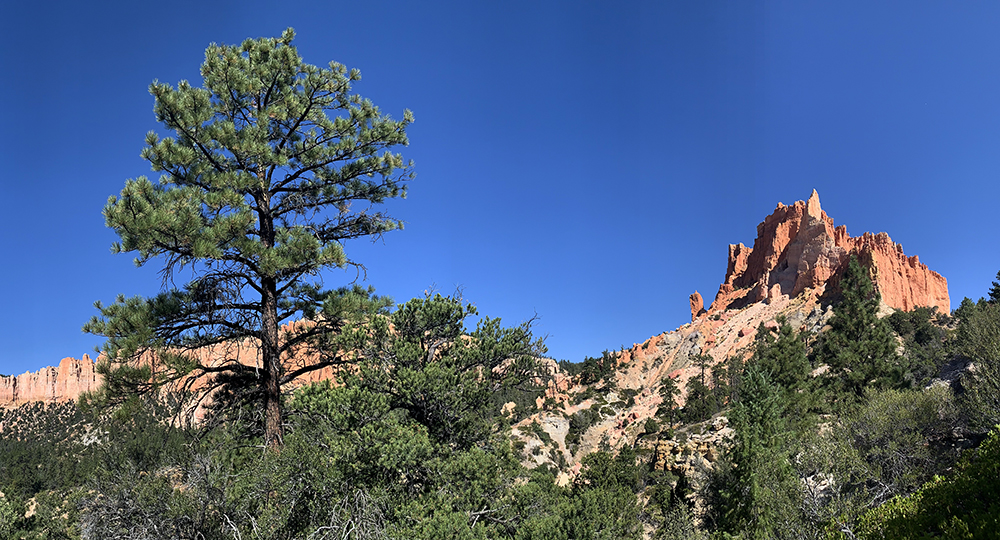
As we neared the Rainbow Point parking area… April instructed the group to stay together during their time at the overlooks. She stressed that the bus would only be here for about 30 minutes. She was good… To punctuate the importance of staying together and being aware of the time, she tossed out a joke that I’m sure she has told many times before. But this joke rang true today, at least for me…
“What’s the difference between a tourist and a hitchhiker at Bryce Canyon?”
“About 5 minutes”….
Oh April, you have no idea how funny that one is…
I got off the bus with the group, thanked April, and said goodbye to the New Jersey ladies. I slowly limped over to Frankie, my trusty metal companion, who was waiting patently in the lot, right where I had left him…
“Good to see you Frankie… Let’s roll…”
Guide to Bryce Canyon
Relevant Links
Ruby Inn – Bryce Canyon Shuttle
Explore Your National Parks

All content found on Park Junkie is meant solely for entertainment purposes and is the copyrighted property of Park Junkie Productions. Unauthorized reproduction is prohibited without the express written consent of Park Junkie Productions.
National Parks and the outdoor recreational activities pursued within their boundaries hold inherent dangers. YOU CAN DIE. I regret to inform you, but you’re going to die anyway… Nevertheless, you are solely responsible for your safety in the outdoors. Park Junkie accepts no responsibility for poor choices made in the wilderness or beyond the controlled area.
Obviously, this site is not affiliated with the National Park Service, or any particular park or park institution. Enjoy your day…
